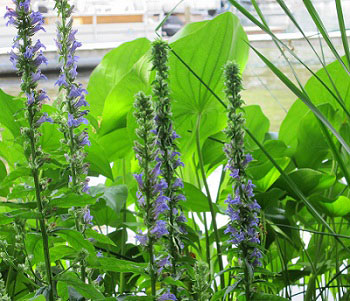Native plants for naturalizing your lakeshore property
Plant selection is key to creating a natural shoreline.
Lakefront property owners thinking of naturalizing their shoreline can access the suggested native plant list of the Michigan Natural Shoreline Partnership (MNSP). Those looking for more in-depth design information may consider the partnership’s new publication entitled, “Natural Shoreline Landscapes for Michigan Inland Lakes: Guidebook for Property Owners.”
Native plants on the MNSP’s list are divided into four shoreline planting zones:
 Below the Water Level: These are the plants that are found in the aquatic zone. Use these plants for planting areas within the lake.
Below the Water Level: These are the plants that are found in the aquatic zone. Use these plants for planting areas within the lake.- Between the Water Level and the Ordinary High Water Mark: These plants like it wet but do not like to actually be in the lake. They can handle frequent water level changes ranging from being flooded for days at a time to being dry for short periods of time. These plants are also the best ones to withstand the energy from wave action and ice push.
- Above the Ordinary High Water Mark: These plants are still considered wetland plants but they are typically further from the lake edge. They like the soil to be consistently moist and they can handle a small amount of flooding. They do not like the constant stress that comes from waves and ice.
- Upland Plants: These plants like dry conditions. This section was included to provide homeowners with native plant suggestions to use in the remaining part of the landscape to allow for opportunities for a comprehensive landscape design.
Additionally, information on the amount of light, plant height, bloom time and color, special adaptive features and the tolerance level to siltation is included in the list. Siltation refers to soil particles building up in a particular area. This puts stress on plants often resulting in reduced growth or reproduction. A high on the plant matrix indicates that a particular plant has a high level of tolerance to siltation.
It should be noted that the Michigan Department of Environmental Quality (MDEQ) prohibits the planting of non-native plants below the Ordinary High Water Mark as regulated by Part 301, Inland Lakes and Streams, of the Natural Resources and Environmental Protection Act, 1994, PA 451, as amended (Part 301). Also, the placement of any type of wave break to protect plantings until establishment requires a Part 301 permit from the MDEQ.
The Michigan Native Plant Producers Association and the Wildflower Association of Michigan are additional sources of information on Michigan native plants.



 Print
Print Email
Email


